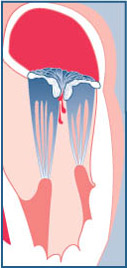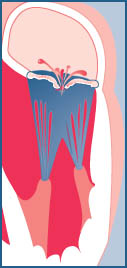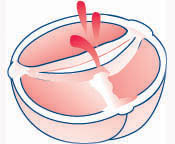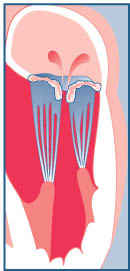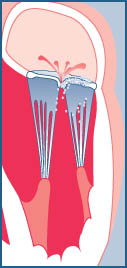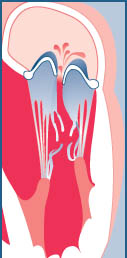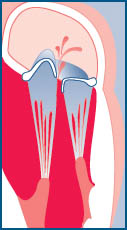There are four valves within your heart. They are the mitral, tricuspid, aortic and pulmonic valves. The valves make sure blood flows in only one direction through the heart. Learn more.
What is heart valve disease?
Valvular heart disease occurs when your heart’s valves do not work correctly. Valvular heart disease can be caused by valvular stenosis or valvular insufficiency.
In the valvular heart disease condition valvular stenosis , the tissues forming the valve leaflets become stiffer, narrowing the valve opening and reducing the amount of blood that can flow through it. If the narrowing is mild, the overall functioning of the heart may not be reduced. However, the valve can become so narrow (stenotic) that heart function is reduced, and the rest of the body may not receive adequate blood flow.
Another valvular heart disease condition, called valvular insufficiency (or regurgitation, incompetence, “leaky valve”), occurs when the leaflets do not close completely, letting blood leak backward across the valve. This backward flow is referred to as “regurgitant flow.”
Stenotic Valve
A narrowed or stenotic valve requires the heart to pump harder, which can strain the heart and reduce blood flow to the body.
Regurgitant Valve
A regurgitant (incompetent, insufficient, or leaky) valve does not close completely, letting blood move backward through the valve.
Some patients may have both valvular stenosis and valvular insufficiency in one or more valves. Valve disease causes the heart muscle to work harder to circulate the right amount of blood through the body.
What causes valve disease?
A person can be born with valve disease (congenital) or develop a problem later in life ( acquired) . Sometimes the cause of valve disease may be unknown.
Download a Free Guide on Valve Disease and Treatment Options
Congenital valve disease
Congenital valve disease develops before birth. Common problems that cause this type of valve disease are abnormal valve size, leaflets that are not properly formed, and abnormal leaflet attachment. This most often affects the aortic or pulmonic valve.
Bicuspid aortic valve disease is a type of congenital valve disease that affects the aortic valve. The valve has two leaflets (cusps) instead of three. Without the third leaflet, the valve may be:
- stenotic - stiff valve leaflets that can not open or close properly
- leaky - not able close tightly (regurgitant).
Bicuspid Aortic Valve - Two Leaflets
Normal Aortic Valve - Three Leaflets
This occurs more frequently in some family members. At least 25 percent of the patients with this disease have a larger than normal aorta above the valve (aortic root). Bicuspid aortic valve disease affects about 2 percent of the population.
Acquired Valve Disease
Acquired valve disease includes problems that develop with valves that were once normal. Acquired disease can be the result of infection, such as infective endocarditis and rheumatic fever. It can also be caused by changes in the valve structure, such as stretching or tearing of the chordae tendineae or papillary muscles, fibro-calcific degeneration or dilatation of the valve annulus. Sometimes the cause of acquired valve disease is unknown.
Infection
Rheumatic fever
Rheumatic fever causes a common type of valve disease, rheumatic heart disease. It causes:
- the heart valve leaflets may become inflamed
- the leaflets may stick together and become scarred, rigid, thickened and shortened
- one or more of the valves (most commonly the mitral valve) may become stenotic (narrowed) or leaky
Rheumatic fever is usually the result of an untreated streptococcal infection, such as strep throat. The use of penicillin to treat strep throat can prevent this disease. Rheumatic fever occurs most often in children aged five to fifteen. It sometimes takes years for symptoms of valve disease to develop. The valve itself is not infected when you have rheumatic fever. Instead, the body produces antibodies to fight the infection, and they react with the heart valves, causing inflammation and eventual scarring.
Endocarditis
Infective endocarditis (also called bacterial endocarditis) is a life-threatening infection of the heart valves or the heart’s inner lining (endocardium).It occurs when germs (especially bacteria, but occasionally fungi and other microbes) enter your blood stream and attach to the surface of your heart valves. With endocarditis:
- germs attack the heart valve, causing growths on the valve, holes in the valve or scarring of the valve tissue
- may cause the valve to leak or become stenotic (narrowed)
The germs can enter your blood stream during:
- dental procedures
- surgery
- intravenous (IV) drug use
- severe infections
If you have valve disease (unless you have mild forms of mitral valve prolapse) or have had valve surgery, you are at increased risk for getting this life-threatening infection. Endocarditis can be deadly if it is not treated.
Other causes of valve disease include:
- coronary artery disease
- heart attacks
- cardiomyopathy (heart muscle disease)
- syphilis
- hypertension
- aortic aneurysms
- connective tissue diseases
- and less commonly, tumors
- some types of drugs and radiation
Structural Types
Changes in your valve structure can occur due to both acquired and congenital causes
These include types of structural valve disease.
Stretching or Tearing of Chordae Tendineae or Papillary Muscles
The valve leaflets may flow backward (flail leaflet) when the ventricles, contract, causing a leaky valve. The mitral valve is most affected. This can be a result of:
- heart attack
- heart valve infection
- trauma
Mitral Valve Prolapse (MVP)
Mitral valve prolapse (MVP) is a type of myxomatous valve disease caused by weaker than normal connective tissue in the mitral valve. The condition causes the leaflets of the mitral valve to flop back into the left atrium when the heart contracts. The tissues of the valve also become abnormal and stretchy, causing the valve to leak.
Normal mitral valve - Leaflets close tightly to keep blood from flowing backward when the ventricle contracts
Mitral valve prolapse - mitral valve leaflets are stretchy, valve may leak
Is mitral valve prolapse serious?
MVP affects about 1 to 2 percent of the population. Men and women have the same risk of MVP. The condition usually is not a reason for concern. Only a small percentage of patients with MVP eventually need surgery. If the prolapse becomes severe or is associated with torn chordae or flail leaflets (floppy, lacking support), it could lead to a bad leak, and surgery may be needed.
All patients with MVP should ask their doctor if they require measures to prevent endocarditis. Learn more about MVP.
Fibro-calcific Degeneration
Fibro-calcific degeneration: The valve opening becomes narrowed. It most commonly affects the aortic valve. It often occurs in adults over age 65. The valve leaflets become fibrotic (thickened) and calcified (hardened), producing a narrowed valve opening. Risk factors for this type of valve disease include:
- increased age
- low body weight
- high blood pressure
Dilatation of the Valve Annulus
Dilatation of the valve annulus causes the valve to leak
The widening or stretching of the valve annulus (dilatation) causes the leaflets to lack support and not close tightly. This leads to leaking of the heart valve.
Dilatation may occur when the heart muscle is damaged due to:
- a heart attack (heart muscle injury)
- cardiomyopathy (weakened heart muscle)
- inherited disorders, such as Marfan syndrome
- heart failure
- advanced stages of high blood pressure
- syphilis
An inherited heart condition, such as Marfan syndrome can cause the aorta to become bigger and keep the aortic valve leaflets from closing properly, leading to valve leaks. This can also happen if the aorta is enlarged for other reasons such as an aneurysm, rheumatological conditions, or high blood pressure.
